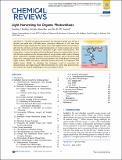Light harvesting for organic photovoltaics
Abstract
The field of organic photovoltaics has developed rapidly over the last 2 decades, and small solar cells with power conversion efficiencies of 13% have been demonstrated. Light absorbed in the organic layers forms tightly bound excitons that are split into free electrons and holes using heterojunctions of electron donor and acceptor materials, which are then extracted at electrodes to give useful electrical power. This review gives a concise description of the fundamental processes in photovoltaic devices, with the main emphasis on the characterization of energy transfer and its role in dictating device architecture, including multilayer planar heterojunctions, and on the factors that impact free carrier generation from dissociated excitons. We briefly discuss harvesting of triplet excitons, which now attracts substantial interest when used in conjunction with singlet fission. Finally, we introduce the techniques used by researchers for characterization and engineering of bulk heterojunctions to realize large photocurrents, and examine the formed morphology in three prototypical blends.
Citation
Hedley , G J , Ruseckas , A & Samuel , I D W 2017 , ' Light harvesting for organic photovoltaics ' , Chemical Reviews , vol. 117 , no. 2 , pp. 796-837 . https://doi.org/10.1021/acs.chemrev.6b00215
Publication
Chemical Reviews
Status
Peer reviewed
ISSN
0009-2665Type
Journal item
Description
The authors are grateful to the Engineering and Physical Sciences Research Council of the UK (grants EP/J009016/1 and EP/L017008/1) and the European Research Council (grant number 321305) for financial support. IDWS also acknowledges a Royal Society Wolfson Research Merit Award.Collections
Items in the St Andrews Research Repository are protected by copyright, with all rights reserved, unless otherwise indicated.

